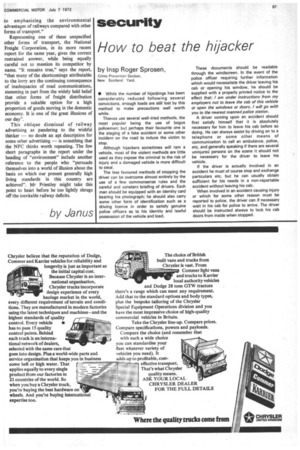security How to beat the hijacker
Page 89

If you've noticed an error in this article please click here to report it so we can fix it.
by Insp Roger Sprosen,
Crime Prevention Section, New Scotland Yard.
• While the number of hijackings has been considerably reduced following several convictions, enough loads are still lost by this method to make precautions well worth while.
Thieves use several well-tried methods, the most popular being the use of bogus policemen; but perhaps their favourite one is the staging of a fake accident or some other incident on the road to induce the victim to stop.
Although hijackers sometimes will ram a vehicle, most of the violent methods are little used as they expose the criminal to the risk of injury and a damaged vehicle is more difficult to steal.
The less favoured methods of stopping the driver can be overcome almost entirely by the use of a few commonsense rules and the careful and constant briefing of drivers. Each man should be equipped with an identity card bearing his photograph; he should also carry some other form of identification such as a driving licence in order to satisfy genuine police officers as to his identity and lawful possession of the vehicle and load. These documents should be readable through the windscreen. In the event of the police officer requiring further information which would necessitate the driver leaving his cab or opening his window, he should be supplied with a properly printed notice to the effect that: / am under instructions from my employers not to leave the cab of this vehicle or open the windows or doors. l will go with you to the nearest manned police station.
A driver coming upon an accident should first satisfy himself that it is absolutely necessary for him to leave his cab before so doing. He can always assist by driving on to a telephone or some other means of communication to call an ambulance, police, etc, and generally speaking if there are several uninjured persons on the scene it should not be necessary for the driver to leave his vehicle.
If the driver is actually involved in an accident he must of course stop and exchange particulars etc, but he can usually obtain sufficient for his needs in a non-reportable accident without leaving his cab.
When involved in an accident causing injury or which for some other reason must be reported to police, the driver can if necessary wait in his cab for police to arrive. The driver should be instructed always to lock his cab doors from inside when stopped.
















































































































































